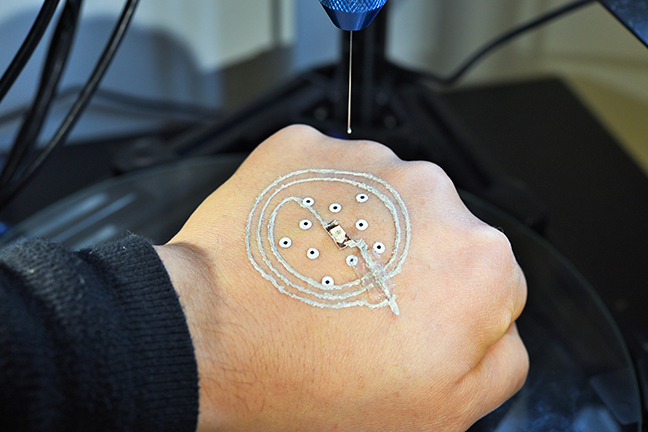Researchers Print Electronics on Human Skin

Latest News
May 11, 2018
For years, researchers and technology companies have been developing new ways to further integrate sensors and other electronics to create a more natural and symbiotic interface for human beings – smart clothes with embedded sensors; smart glasses for heads-up displays; and even small electronics that can be swallowed for medical diagnoses.
Researchers at the University of Minnesota have found a way to use 3D printing to further integrate people and electronics. They have demonstrated a way to use a 3D printer to print electronics on human skin.

The technology could be used to print temporary sensors on the bodies of soldiers, for example, to detect chemical or biological weapons. Printed solar cells could also be used to charge electronics. And the team also printed biological cells on the skin wound of a mouse, which could open up new types of wound treatment processes.
“We are excited about the potential of this new 3D-printing technology using a portable, lightweight printer costing less than $400,” said Michael McAlpine, the study’s lead author and the University of Minnesota Benjamin Mayhugh Associate Professor of Mechanical Engineering. “We imagine that a soldier could pull this printer out of a backpack and print a chemical sensor or other electronics they need, directly on the skin. It would be like a ‘Swiss Army knife’ of the future with everything they need all in one portable 3D printing tool.”
The human body is an imperfect (and often twitchy) build platform, so the team came up with a technique that allows the printer to adjust to small movements during the printing processes. The printer uses computer vision to follow a pattern based on temporary markers placed on the skin. The process also uses an ink that can be cured at room temperature.
“No matter how hard anyone would try to stay still when using the printer on the skin, a person moves slightly and every hand is different,” McAlpine said. “This printer can track the hand using the markers and adjust in real-time to the movements and contours of the hand, so printing of the electronics keeps its circuit shape.”
The printed electronics can be peeled or washed off after use.
The research was published in the journal Advanced Materials.
Source: University of Minnesota
Subscribe to our FREE magazine, FREE email newsletters or both!
Latest News
About the Author
Brian Albright is the editorial director of Digital Engineering. Contact him at [email protected].
Follow DE





